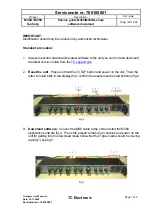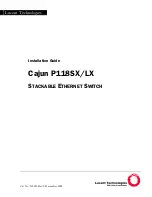
1-3
Introduction to NDP
NDP is used to discover the information about directly connected neighbors, including the device name,
software version, and connecting port of the adjacent devices. NDP works in the following ways:
z
A device running NDP periodically sends NDP packets to its neighbors. An NDP packet carries
NDP information (including the device name, software version, and connecting port, etc.) and the
holdtime, which indicates how long the receiving devices will keep the NDP information. At the
same time, the device also receives (but does not forward) the NDP packets from its neighbors.
z
A device running NDP stores and maintains an NDP table. The device creates an entry in the NDP
table for each neighbor. If a new neighbor is found, meaning the device receives an NDP packet
sent by the neighbor for the first time, the device adds an entry in the NDP table. If the NDP
information carried in the NDP packet is different from the stored information, the corresponding
entry and holdtime in the NDP table are updated; otherwise, only the holdtime of the entry is
updated. If no NDP information from the neighbor is received when the holdtime times out, the
corresponding entry is removed from the NDP table.
NDP runs on the data link layer, and therefore supports different network layer protocols.
Introduction to NTDP
NTDP provides information required for cluster management; it collects topology information about the
devices within the specified hop count. Based on the neighbor information stored in the neighbor table
maintained by NDP, NTDP on the management device advertises NTDP topology collection requests to
collect the NDP information of all the devices in a specific network range as well as the connection
information of all its neighbors. The information collected will be used by the management device or the
network management software to implement required functions.
When a member device detects a change on its neighbors through its NDP table, it informs the
management device through handshake packets. Then the management device triggers its NTDP to
collect specific topology information, so that its NTDP can discover topology changes timely.
The management device collects topology information periodically. You can also administratively
launch a topology information collection. The process of topology information collection is as follows:
z
The management device periodically sends NTDP topology collection request from the
NTDP-enabled ports.
z
Upon receiving the request, the device sends NTDP topology collection response to the
management device, copies this response packet on the NTDP-enabled port and sends it to the
adjacent device. Topology collection response includes the basic information of the NDP-enabled
device and NDP information of all adjacent devices.
z
The adjacent device performs the same operation until the NTDP topology collection request is
sent to all the devices within specified hops.
When the NTDP topology collection request is advertised in the network, large numbers of network
devices receive the NTDP topology collection request and send NTDP topology collection response at
the same time, which may cause congestion and the management device busyness. To avoid such
case, the following methods can be used to control the speed of the NTDP topology collection request
advertisement:
z
Upon receiving an NTDP topology collection request, each device does not forward it, instead, it
waits for a period of time and then forwards the NTDP topology collection request on the first
NTDP-enabled port.
z
On the same device, except the first port, each NTDP-enabled port waits for a period of time and
















































